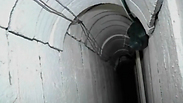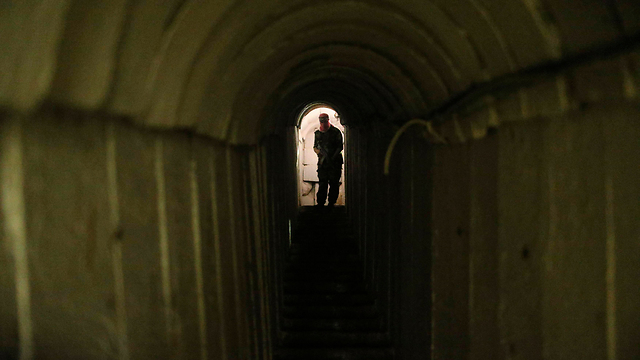
Hamas reconstructing terror tunnels using Israeli materials
Sources in Gaza say Hamas has started to prepare for next conflict with Israel, group said shifting war strategy in wake of Iron Dome, from long-range missiles to short-ranged mortars, coupled with multiple terror cell attacks.
Hamas has been commandeering building materials from Israel transferred into the Gaza Strip for reconstruction for the purpose of rebuilding its offensive 'terror tunnels', Ynet has learned from sources inside Gaza - only four months after a 50-day war which saw Israel target the tunnels.
Meanwhile, a Code Red rocket alert siren was heard in Israel's Eshkol Regional Council located close to the Gaza border, indicating a rocket was fired at Israel. It was later confirmed the rocket had landed in Israeli territory.
Gaza was blockaded by Israel and Egypt for years before the summer's Operation Protective Edge, which ended in August, partly because terrorists were using materials to build fortifications and tunnels under the border. Only in mid-October did Israel allow new materials to start entering the Strip - their oversight a key point in the ceasefire agreement between Israel and Hamas.
After the war, Hamas internalized that the tunnels were pivotal to their fight against Israel, and thus after months of keeping a low profile, Hamas' military wing has begun reconstruction on their strategic asset.
According to Palestinian sources in the Strip who spoke to Ynet, after Israel allowed the flow of limited goods and materials into Gaza, a black market for mortar emerged - allowing Hamas to renew construction of concrete slabs used to line the inside of the tunnels.
As part of its policy, Hamas has already begun preparing for the next round of fighting with Israel. Part of this effort and in addition to reconstructing the tunnels, Hamas has also reportedly begun rebuilding its missile and rocket arsenal from "dual-use" materials, such as iron, which can be used to create weapons.
These types of materials are also smuggled in illegally through the Rafah crossing with Egypt or by sea. Smuggling tunnels reaching into Egypt are also utilized, though few remain after the Egyptian authorities' crackdown on the Sinai border a few months ago, which destroyed the majority of the tunnels.
In recent weeks Hamas has also tested a number of rockets, conducting a number of test launches into the sea.
In the wake of the Iron Dome missile defense system's impressive sucess during the war – according to the IDF, the system shot down close to 80 percent of rockets fired at Israel – Hamas has come to understand that short range mortars that fall under the system's radar are more effective than mid-range missles fired at Tel Aviv which are shot down midair. A short-range version of Iron Dome is said to be in the works, though it is not yet operational.
Hamas is now formulating a new war strategy, which will see large groups of terrorist penetrating into Israel through tunnels the next round of fighting in the hopes of hitting the army and civilians behind the front line. It is possible this new strategy was inspired by Hezbollah's fighting tactics along the Israeli northern border with Lebanon.
Hamas has also appointed two new regional commanders, replacing Raid al-Atar, the Rafah regional commander, and Mohammed Abu Shmala, in charge of the southern part of the Strip, after both were taken out by Israel during the fighting.
Nonetheless, despite its preparations, Hamas is holding its militants and other Gaza terror factions on a short leash, barring any rocket fire from the Strip. Hamas security forces have even worked to prevent fringe groups from firing at Israel and have arrested those who have launched rockets, some of which landed in Israel and others, failing to make it across the border, landed in Gaza.
Reuters contributed background material for this report












